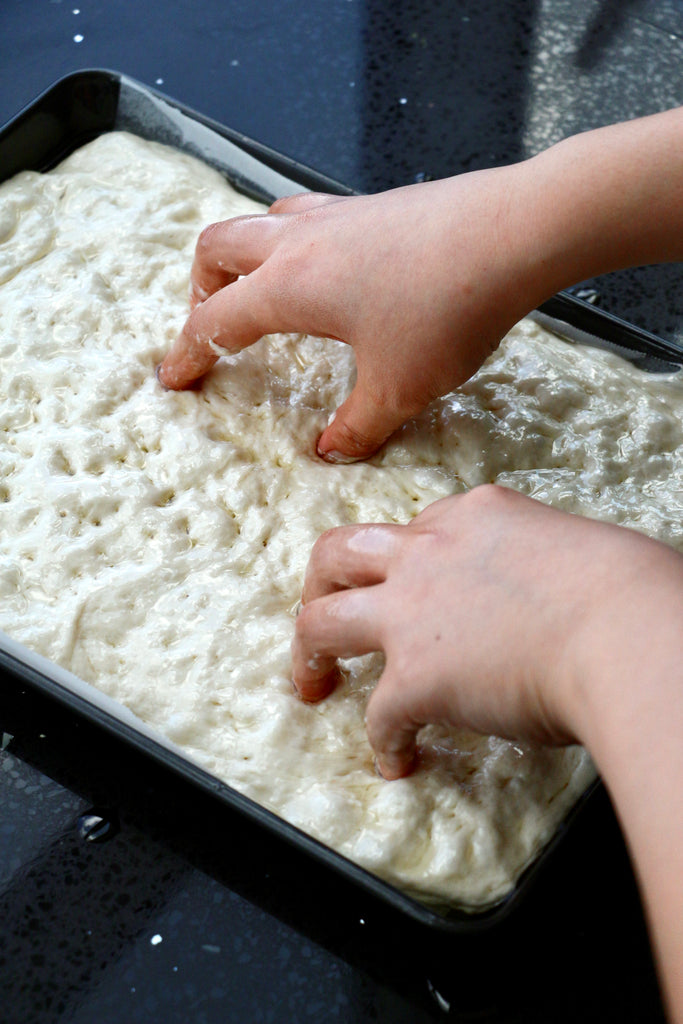Our signature pineapple tarts baking kits are coming back soon!
- About Us
- CHRISTMAS KITS
-
Baking Kits
- contact us
Our signature pineapple tarts baking kits are coming back soon!
December 27, 2022
We all have different preferences when it comes to eating cookies. Some prefer small and crunchy cookies, while others find thick and chewy cookies more appealing.
If you are one of those who love big, chunky, soft, and cake-like cookies, then you should try our White Chocolate, Cranberry & Strawberry NY Cookies recipe inspired by the famous Levain-bakery! [Go straight to recipe]
While the NY stands for New York here, these will be an absolute hit at your New Year's gatherings.
Levain Bakery isn’t an unfamiliar name for cookie enthusiasts.
The iconic Levain cookies can be found in any branch of Levain Bakery in the States, but if you’re like us and are in a place without access to it, the next best thing is to recreate a version that reminds us of it.
Since its emergence in 1995, Levain cookies have become an iconic NYC signature that has stolen the hearts of many locals and visitors alike.
People around the world have always tried to create their own Levain style cookies: huge New York-style cookies that are almost palm-sized with a crisp outside and a soft and chewy inside.
Here, we've made a version with some dried cranberries and freeze-dried strawberries to give it a sort of tang that complements the sweetness in the cookie.
Read More: Umami White Chocolate Miso Japanese Cookies
If you’ve been googling for Levain cookie recipes, you may find that most of them are soft-baked cookies loaded up with chocolate or white chocolate chips. But hey, no one can stop you from tweaking the recipe to your liking!
There are no limitations when it comes to adding mix-ins to your cookies (unless it dramatically increases the water content). You can add a bunch of macadamia nuts, peanut butter, chocolate or rainbow sprinkles, marshmallows, etc. If you want to add a slight tang, dried cranberries are the perfect choice.

One of the key traits of a Levain-style cookie is its large and tall size, coupled with a fudgy center.
The key to reaching this is to prevent spreading of the cookie while not incorporating too much air. For that, we use cold, cubed butter, and chilling the dough just before it’s baked.
You’ll need a hand-mixer for this one, because whisking cold butter with a hand-whisk is going to make you flip!
Other than that, cold butter helps to elevate crispness in the cookies. When you mix cold butter with the dough, instead of being fully incorporated, it gets broken into small pieces instead.
As a result, during baking, the steam released will create flaky layers.
Yield: ~20 cookies
Enjoy baking and want to get better at it? We post new recipes and tips all the time! Stay tuned by joining our newsletter or follow us on Instagram @bakestarters.
Sign up for our free newsletter
Trying this recipe out? Make sure you hashtag #bakestarters on Instagram so we can see your wonderful creations!
December 20, 2022
Christmas celebrations and delectable meals are almost a tradition in itself. Focaccia is one of many Christmas dishes that goes well with almost everything. Just like brioche bread, it can be sweet or savoury.
When it comes to enjoying focaccia bread, this versatile treat can be enjoyed with a variety of companions like soups, meat, vegetables, pasta, sausage, and any other dish. [Go straight to recipe]
If you want to make this year’s Christmas more festive, we have an incredibly flavourful Focaccia With Garlic Confit And Rosemary recipe that could enliven your Christmas feast.

While most bread has a domed structure, it’s different for focaccia. Focaccia is known for its flat surface.
Even though it uses similar ingredients and techniques to regular bread, a focaccia recipe yields a delicious flatbread with a golden brown and crispy outside.
A focaccia's signature look is its dimples on the top. Those dimples are due to the “dimpling” process where the dough is gently pressed with fingers so that it creates little indentations.
These dimples aren’t simply for aesthetic purposes — they also have an important role in deflation reducing the air. When we want flatbread, it is important to keep the dough from rising.
One of the ways to prevent rising dough is by poking the dough with your fingers, so it forms dimples that will result in flatter bread when you bake it.
The ideal method to dimple your focaccia is first, you can drizzle olive oil all over the top or wet your fingers with it.
Then, gently push your fingers into the dough. Make sure you are not poking it all the way down as it will create leaks.
Dimpling your focaccia can also intensify the flavour of your focaccia since the olive oil is being pushed deeper into the dough.

Kneading is the process in a focaccia bread recipe that allows the bread to have the perfect structure. It is a technique in making the dough come together, a technique which includes stretching and increasing the gluten contained in the dough.
If you want a quick and easy kneading process, an electric stand mixer will be immensely helpful.
However, kneading by hand is fun too! All you have to do is stretch, fold, and rotate your dough repeatedly until the dough becomes smooth and elastic..
For a complete step-by-step kneading of the dough with your bare hands, you can learn it here.
Hate kneading? Try This No Knead Cinnamon Nutmeg Raisin Bread.
Focaccias can be adorned with different toppings and flavours to make your own unique bread.
If you want to satisfy your sweet tooth, you can top your focaccia with chocolate chips, maple syrup, dried berries, powdered or even granulated sugar.
Meanwhile, when it comes to making savoury focaccia, there are many more options.
The most famous of all is the garlic and cheese focaccia recipe which includes freshly baked focaccia bread topped with garlic, butter, herbs, and parsley. Here's one we made with rosemary and olives!

There are also other combinations, like rosemary potato, veggies focaccia, black olives, caramelised onion, broccoli, mozzarella sandwich, and our authentic Christmas focaccia: garlic confit and rosemary.
WATCH:
Yield: 30cm x 30cm pan / 10-12 servings
Note:
*This can be replaced with any vegetable oil, but extra virgin olive oil will give the focaccia more intense flavors.
**You can infuse chili flakes into the garlic confit to add some heat to your focaccia.
Storage/Serving notes: Lasts up to three days. Store it in an airtight container at room temperature. Can be served on its own or dipped in an olive oil and parmesan combo. This is also a great substitute to your regular sandwich bread.
Addtional notes***: At Step 8 of making the focaccia, you can let the dough rest up to 24 hours.
Instructions: In the same greased bowl as before, shape your dough into a ball and cover your bowl using plastic wrap. Let your dough slowly rise in the fridge overnight or up to 24 hours; this will give your dough more time to ferment and, therefore, develop more structure and flavors. Make sure you grease your plastic wrap to prevent it from sticking to the dough. If doing this, store garlic confit in the fridge in an airtight container.
Loving our bread recipes? Sign up to our newsletter to get more bread recipes and tips and tricks on baking perfect loaves of bread!
Sign up for our free newsletter
Trying this recipe out? Make sure you hashtag #bakestarters on Instagram so we can see your wonderful creations!
Read Next: French Brioche With An Italian Twist: Ultra Soft Tiramisu Maritozzi
December 14, 2022
Isn’t it hard to resist the softness of a chiffon cake?
Typically, a Christmas log cake comes with chocolate or whipped cream.
Here we have a special Swiss Roll recipe with a bittersweet kick, courtesy of hojicha and some smokiness from a caramel filling. [Go straight to recipe]

The base for this Hojicha Log Cake With Caramel Mousse is a pillowy swiss roll. If you already know how to make a Swiss Roll, yielding your desired log cake will be relatively simple.
Read More: Spill The Tea - Our Guide To Using Tea In Your Baking Recipes
If you are a beginner, read on.There are a few keys to a light and soft Swiss Roll.
The tenderness and lightness of a swiss roll cake comes from the cake flour and chemical leaveners. Cake flour has a smaller percentage of protein content which produces less gluten, so your cake will stay soft.
Another key part of making a Swiss Roll like this is in the use of an egg white meringue to provide air to your batter. This makes your Swiss Roll incredibly light and fluffy.
Instead of a sponge cake, we opted to use a chiffon cake for our Swiss Roll.
A Swiss Roll is all about the softness. The basic requirement of an ideal chiffon cake is one that is moist, light, and fluffy.
In every chiffon cake recipe, the first step is always to bring your ingredients to room temperature. However, since we will be using milk to dissolve the hojicha powder, we’ll warm the milk up instead.
Oil is used instead of butter in a chiffon cake to keep the cake moist and light. Whenever you want to make a cake less dry, oil is a good ingredient to bet on, primarily because it stays liquid at room temperature.
Use a vegetable oil that doesn’t impart strong flavours, such as canola!
Using a strong-flavoured oil like olive oil for baking is generally not recommended, due to the lower smoking point and the flavours it imparts to your baked goods.
Read More: 10 Cake Frosting Tips To Nail Your First Cake
The most important tip when rolling your swiss roll is that you have to roll your cake while it’s warm. For a much better result, this step needs to be done carefully.
Why does the cake have to be rolled while it’s still warm?
Rolling a sponge cake while it’s warm will spare you the disappointment from a cracked surface. When the cake is warm, it’s more malleable and thus, allows you to roll the cake without cracking.
Letting the cake cool in its rolled form will let it set in that shape, and when you finally put your fillings in, rolling it again without cracking will be far easier.
After diving into the world of a classic Swiss Roll, now it’s time for you to make one!
We took a bit of creative freedom with this by making it a hojicha log cake filled with a caramel mousse, then topped off with a whipped chocolate ganache.
Verdict? Absolutely divine!

Yield: ~6x servings
Storage: Best served immediately. Can be stored in the fridge and in an airtight container, can last up to three days.
Read More: Guide To Soft, Medium, Firm, And Stiff Peaks
Trying this recipe out? Make sure you hashtag #bakestarters on Instagram so we can see your wonderful creations!
December 06, 2022
December 02, 2022
November 30, 2022
November 25, 2022 8 Comments
December 17, 2020
December 11, 2020
November 25, 2020
November 19, 2020
